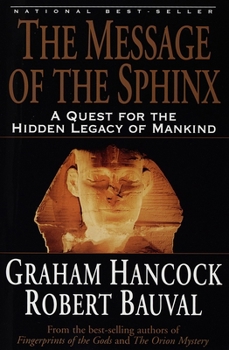The Message of the Sphinx: A Quest for the Hidden Legacy of Mankind
Select Format
Select Condition 
Book Overview
NATIONAL BESTSELLER - Two Egypt experts posit a revolutionary theory: The Sphinx and other great Egyptian monuments are older than common history books tell us and are arranged in such a way as to send us a message from the silent past. Guardian of the ancient mysteries, the keeper of secrets . . . For thousands of years the Great Sphinx of Egypt has gazed toward the east, its eyes focused on eternity, reading a message in the...
Format:Paperback
Language:English
ISBN:0517888521
ISBN13:9780517888520
Release Date:May 1997
Publisher:Crown Publishing Group (NY)
Length:400 Pages
Weight:1.03 lbs.
Dimensions:0.8" x 6.1" x 9.2"
Customer Reviews
3 ratings
compelling and well researched
Published by Thriftbooks.com User , 25 years ago
When I first saw this book at a bookstore, I figured it was another one of those goofy conspiracy-theory books. This time the bad guy was academia and they were conspiring to keep us from the truth about the Sphinx.Thank goodness I actually gave the book a try. It's incredibly well written, full of well-documented facts and packed with footnotes and pictures. Hancock and Bauval turn out not to be conspiracy cranks at all; they have found amazing evidence about the age and orientation of the Sphinx and the pyramids. The problem is that the evidence flies in the face of everything that Egyptologists want to believe.I went on to read source material on the Sphinx and am now reading Hancock's "Fingerprints of the Gods" and am now more convinced than ever that Hancock and Bauval speak the truth.Pseduo-scientists? Well, only if you think that you have to be a PhD to do painstaking research. Sometimes all it takes is a dediction to discovering the truth.
Extraordinary, fascinating
Published by Thriftbooks.com User , 25 years ago
I am an avid reader of Scientific American--and this is an extraordinarily interesting book. Intelligently written, well-researched, each chapter presents new discoveries and surprises--some of which are astonishing for their implications. Here, perhaps for the first time in a single reference, is a recounting of all the remarkable achievements of the pyramid builders with ample evidence to document just how fantastic those achievements were. The scientific community's notion of people putting 200 ton blocks of stone in place with precision by sliding them up long ramps of mud is preposterous--now here is the engineering to prove it. The book argues that the pyramids were built by a much older civilization of great wisdom and practical knowledge. The book also provides an intelligent account of the importance of eastern (Vedic) astrology in the spiritual journey of mankind, at least as accepted by the ancients. One caveat: The book is an easy read--an exciting book--and I sent it to five friends, four of whom couldn't get through it. The fifth loved it. You will need to have an interest in the subject manner and scientific detail. This is not a book that replaces scientific reasoning with easily rebuked, flaky theories so popular with the Atlantis/Aliens crowd.
A FASCINATING NEW ANGLE ON EGYPTOLOGY
Published by Thriftbooks.com User , 28 years ago
How old is the Sphinx? The question, and it's paradigm-busting potential for Egyptology, and history as a whole, is the subject of this compelling book. € Robert Bauval, a Belgian engineer, and Graham Hancock, former East Africa correspondent for the Observer, have authored previous bestsellers on archaeological mysteries of the ancient world. Here they combine forces to question the conventional wisdom regarding Ancient Egypt, and step bravely into the academic no-man's land that lies between history and prehistory. € It was Bauval who made the discovery that the Great Pyramids are exact likenesses, in position and scale, of the three stars in the belt of Orion. Hancock, for his part, claims that the precisely engineered structures of the Gizeh plateau are repositories of complex astronomical data. In The Message of The Sphinx the authors conclude that the Ancient Egyptians were heir to a civilization much greater and older than their own. € The most compelling evidence in this regard was announced in 1993, when evidence was presented at a meeting of the American Association for the Advancement of Science that the Sphinx is thousands of years older than previously thought. € This haunting monument, the authors assert, with its refashioned, possibly once-leonine head, was created in 10,500 BC. The creators of the Sphinx were survivors of a primordial catastrophe that wiped out most of their civilization. € Hancock and Bauval point to the "followers of Horus" in ancient texts as dim memories of these survivors, and suggest the ancient Egyptians were inheritors -- not originators -- of their complex cosmology. The pyramids were completed at a later date than the Sphinx, and the authors present the extraordinary possibility that these enormous stuctures (particularly the great pyramid of Khufu, with its complex galleys and passages) were not meant as tombs at all, but as architectural maps of a region of the heavens known as the "duat", centered in Orion: the cosmogenic realm where souls are spawned and return upon death. The pyramids were used, they theorize, for ritualistic reenactments of astronomical events. € The author's labours have made for a mind-bending read, though Hancock and Bauval's ultimate vindication awaits the archaeologist's spade.






